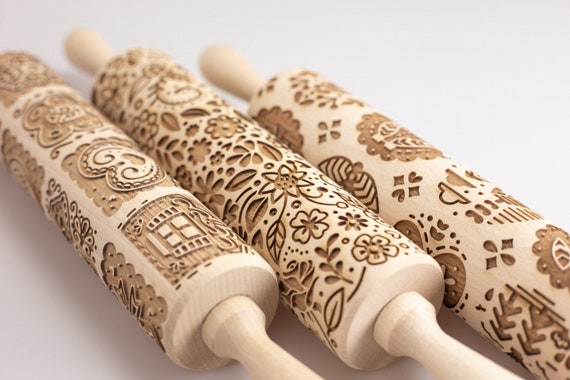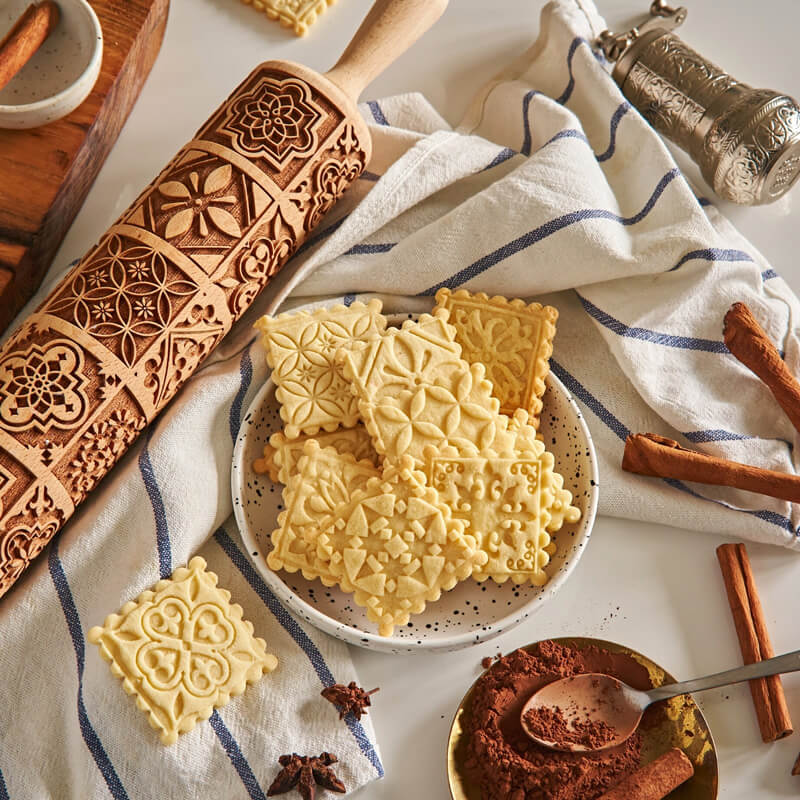As a baking enthusiast, I can confidently say that the right tools can make all the difference in the world. One tool that has become a staple in my kitchen is the decorative rolling pin. Not only do they serve a functional purpose, but they also bring a touch of artistry to baking. In this extensive guide, we will explore everything there is to know about decorative rolling pins, including types, materials, how to use them, and valuable tips for choosing the best one for your baking needs.
What is a Decorative Rolling Pin?
A decorative rolling pin is a specialized kitchen tool designed to roll out dough while simultaneously imprinting patterns or designs onto the surface. These rolling pins come in a variety of styles, sizes, and designs, allowing bakers to create beautiful cookies, pies, and other baked goods that are not only delicious but also visually appealing.
Types of Decorative Rolling Pins
When it comes to decorative rolling pins, there are several types to consider. Each type offers unique benefits and features that can enhance your baking experience.
1. Engraved Rolling Pins
Engraved rolling pins are perhaps the most popular type of decorative rolling pins. They feature intricate designs carved into the wood, allowing bakers to create detailed patterns in their dough.
2. Embossed Rolling Pins
Embossed rolling pins have raised designs that create texture in the dough. These are great for creating subtle patterns that can add depth to your baked goods.

3. Silicone Rolling Pins
Silicone rolling pins are flexible and non-stick, making them easy to use with a variety of dough types. Some silicone pins come with engraved designs, offering the best of both worlds.
4. Customizable Rolling Pins
For those looking to take personalization to the next level, customizable rolling pins are available. These can be engraved with names, dates, or custom designs, making them perfect for gifts or special occasions.

Benefits of Using Decorative Rolling Pins
Using a decorative rolling pin can significantly enhance your baking experience. Here are some of the key benefits:
1. Adds Visual Appeal
One of the most obvious benefits of using a decorative rolling pin is the beautiful designs it adds to your baked goods. Whether you’re making cookies, pies, or bread, the patterns can elevate your presentation.

2. Saves Time on Decorating
With an engraved or embossed rolling pin, you can achieve stunning designs without spending hours decorating each piece by hand. This is especially useful during busy baking seasons like the holidays.
3. Encourages Creativity
Using decorative rolling pins can inspire you to try new recipes and techniques. The possibilities are virtually endless when you start experimenting with different designs and dough types.

4. Great for Special Occasions
Whether it’s a birthday, wedding, or holiday gathering, decorative rolling pins allow you to add a personal touch to your baked goods that will impress your guests.
Choosing the Right Decorative Rolling Pin
With so many options available, selecting the right decorative rolling pin can be a daunting task. Here are some factors to consider:

1. Material
Decorative rolling pins come in various materials, including wood, silicone, and metal. Each material has its pros and cons:
| Material | Pros | Cons |
|---|---|---|
| Wood | Durable, classic aesthetic, good for detailed patterns | Can be heavy, requires maintenance |
| Silicone | Non-stick, easy to clean, lightweight | Less traditional feel, designs may not be as intricate |
| Metal | Durable, often lighter than wood, can be very sleek | Can stick to dough if not greased, may not have designs |
2. Design
Consider the types of designs you want to create. Look for rolling pins that feature patterns that align with your personal style or the occasions you are baking for.

3. Size
Rolling pins come in various sizes. If you frequently bake large batches, a longer rolling pin may be more beneficial. Conversely, for smaller projects or detailed designs, a shorter pin may suffice.
4. Ease of Use
Look for features such as comfortable handles and a weight that feels good in your hands. The best decorative rolling pins should feel natural to use.

Tips for Using Decorative Rolling Pins
To get the best results from your decorative rolling pin, follow these tips:
1. Chill Your Dough
Chilling your dough before rolling it out can help the patterns hold better and prevent sticking. Aim for at least 30 minutes in the refrigerator.
2. Dust with Flour
Lightly dusting your rolling pin and dough with flour can prevent sticking and ensure clean patterns. Be careful not to use too much flour, as this can affect the texture of your dough.
3. Roll Evenly
To achieve consistent imprints, apply even pressure while rolling. This may take some practice, but it’s key to getting those beautiful designs to show up perfectly.
4. Clean After Use
Properly clean your rolling pin after each use to maintain its condition. For wooden pins, a simple wipe down with a damp cloth and a quick dry is often sufficient. Avoid soaking them in water.
Comparison of Popular Decorative Rolling Pins
To help you choose the perfect decorative rolling pin, I’ve compiled a comparison of some of the most popular models currently available.
| Brand/Model | Type | Material | Designs Available | Price Range |
|---|---|---|---|---|
| Rolling Pin Co. Engraved | Engraved | Wood | Floral, Geometric | $20 – $30 |
| Cookie Stamps Silicone | Embossed | Silicone | Textured Patterns | $15 – $25 |
| Custom Rollers Elite | Customizable | Wood | Custom Designs | $40 – $60 |
| Eco-Friendly Rolling Pin | Embossed | Bamboo | Nature Themes | $25 – $35 |
Frequently Asked Questions (FAQs)
1. Can I use a decorative rolling pin for bread dough?
Yes, decorative rolling pins can be used for bread dough. However, keep in mind that the dough for bread is often more elastic, which may affect how the design appears. It’s best to use them on less sticky and more pliable doughs like cookie or pie crust dough for optimal results.
2. How do I clean my decorative rolling pin?
Cleaning your decorative rolling pin depends on the material. For wood, simply wipe it down with a damp cloth and let it air dry. For silicone, you can wash it in warm, soapy water or place it in the dishwasher (if dishwasher-safe).
3. Can I use a decorative rolling pin for fondant or modeling chocolate?
Absolutely! Decorative rolling pins work wonderfully with fondant and modeling chocolate. Just be sure to dust them lightly with cornstarch or powdered sugar to prevent sticking.
4. Are there any types of dough that should not be rolled with decorative rolling pins?
While most doughs can be used with decorative rolling pins, very sticky doughs may not yield clean patterns. Make sure to chill sticky doughs before rolling and lightly dust with flour or cornstarch.
Conclusion
Decorative rolling pins are an excellent addition to any baker’s toolkit. They combine functionality with artistry, allowing you to create stunning baked goods that taste as good as they look. With the variety of styles and designs available, you can find the perfect rolling pin to suit your baking needs and personal style.
Whether you’re making cookies for a birthday party, pie crusts for a holiday gathering, or just want to impress your family with beautifully designed bread, a decorative rolling pin is the ideal tool to help you achieve your baking goals. Happy baking!